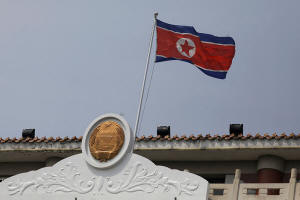|
The missiles were fired at around 7 a.m. (2200 GMT on Tuesday)
and the launches were being analysed by South Korean and U.S.
intelligence, the JCS said in a statement.
It did not specify how many missiles were fired but said further
activities by the nuclear-armed North were being monitored.
While U.N. Security Council sanctions targeting the North's
weapons development do not bar testing of conventionally armed
cruise missiles, South Korea's defence minister Shin Won-sik
condemned the launches as a serious threat to his country.
During a visit to the 17th Fighter Wing, an F-35 stealth fighter
unit, Shin also warned that the North Korean leader's regime
would face its demise if it started a war.
"If Kim Jong Un makes the worst choice and starts a war, you as
an invisible force that protects South Korea should become the
vanguard in removing the leadership of the enemy as soon as
possible," Shin said.
The latest firing of missiles by Pyongyang comes as the South
Korean Navy's special warfare unit was taking part in training
along the east coast in Gangwon Province bordering the North for
10 days.
The training was aimed at strengthening operational readiness
following North Korea's recent artillery firing near a disputed
maritime border and weapons tests, the JCS said.
Pyongyang said it tested a solid-fuel hypersonic missile with
intermediate-range earlier this month in a move that was
condemned by the United States, South Korea and Japan.
The North's state media also said last week the country
conducted a test of its nuclear-capable underwater attack
drones, in a protest against joint military drills by South
Korea, the United States and Japan.
The isolated North has also demolished a major monument in its
capital that symbolized the goal of reconciliation with South
Korea on the orders of leader Kim, who last week called the
rival a "primary foe" and said unification was no longer
possible.
Satellite imagery of Pyongyang on Tuesday showed that the
monument, an arch symbolizing hopes for Korean reunification
which was completed after a landmark inter-Korea summit in 2000,
was no longer there, according to a report by NK News, an online
outlet that monitors North Korea.
Reuters could not independently confirm that the monument, known
informally as the Arch of Reunification, had been demolished.
(Reporting by Hyunsu Yim; Editing by Ed Davies and Raju
Gopalakrishnan)
[© 2024 Thomson Reuters. All rights
reserved.]
Copyright 2022 Reuters. All rights reserved. This material may
not be published, broadcast, rewritten or redistributed.
Thompson Reuters is solely responsible for this content.

|
|




